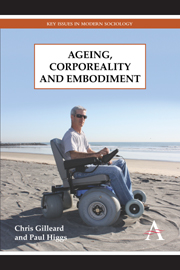Book contents
- Frontmatter
- Contents
- Introduction
- Chapter 1 Identity, Embodiment and the Somatic Turn in the Social Sciences
- Chapter 2 Corporeality, Embodiment and the ‘New Ageing’
- Chapter 3 Gender, Ageing and Embodiment
- Chapter 4 Age and the Racialised Body
- Chapter 5 Disability, Ageing and Identity
- Chapter 6 Sexuality, Ageing and Identity
- Chapter 7 Sex and Ageing
- Chapter 8 Cosmetics, Clothing and Fashionable Ageing
- Chapter 9 Fitness, Exercise and the Ageing Body
- Chapter 10 Ageing and Aspirational Medicine
- Conclusions: Ageing, Forever Embodied
- References
- Index
- ADVANCE PRAISE
Introduction
Published online by Cambridge University Press: 05 July 2013
- Frontmatter
- Contents
- Introduction
- Chapter 1 Identity, Embodiment and the Somatic Turn in the Social Sciences
- Chapter 2 Corporeality, Embodiment and the ‘New Ageing’
- Chapter 3 Gender, Ageing and Embodiment
- Chapter 4 Age and the Racialised Body
- Chapter 5 Disability, Ageing and Identity
- Chapter 6 Sexuality, Ageing and Identity
- Chapter 7 Sex and Ageing
- Chapter 8 Cosmetics, Clothing and Fashionable Ageing
- Chapter 9 Fitness, Exercise and the Ageing Body
- Chapter 10 Ageing and Aspirational Medicine
- Conclusions: Ageing, Forever Embodied
- References
- Index
- ADVANCE PRAISE
Summary
‘In man the changes are familiar: the skin is pale, often yellowish, wrinkled, and inelastic. On the backs of the hands purpura is common and there is patchy pigmentation of brownish hue. The hair is white and often sparse; the back is bowed, the limbs are sometimes tremulous, and the teeth are lost. Movement is slow and often clumsy. There is a tendency to fall, and […] the fears of accident may be so great that they dominate the life of the old person. Muscular effort entails distress, especially with breathing. Sleep is short and easily disturbed, though drowsiness is frequent. Vision fails and deafness is common. Sexual desire wanes […]’
—A. P. Thomson, ‘Problems of Ageing and Chronic Sickness’, British Medical Journal 2 (1949): 302Ageing is not what it once was. That was the premise of our first book, Cultures of Ageing (2000) and it continues to guide the present one. From Thomson's time when the above was published to the first decade of the twenty-first century, profound changes have taken place in our understanding and interpretation of ageing and old age. During this period, old age as a distinct social category has collapsed while ageing itself has lost much of its former coherence. Age as ‘old age’ has been replaced by the feared social imaginary of a ‘fourth age’ (Gilleard and Higgs 2010) while the ageing ‘process’ has become caught up in the puzzling, cultural complexity that is the ‘third age’ (Gilleard and Higgs 2011a).
- Type
- Chapter
- Information
- Ageing, Corporeality and Embodiment , pp. vii - xivPublisher: Anthem PressPrint publication year: 2013



